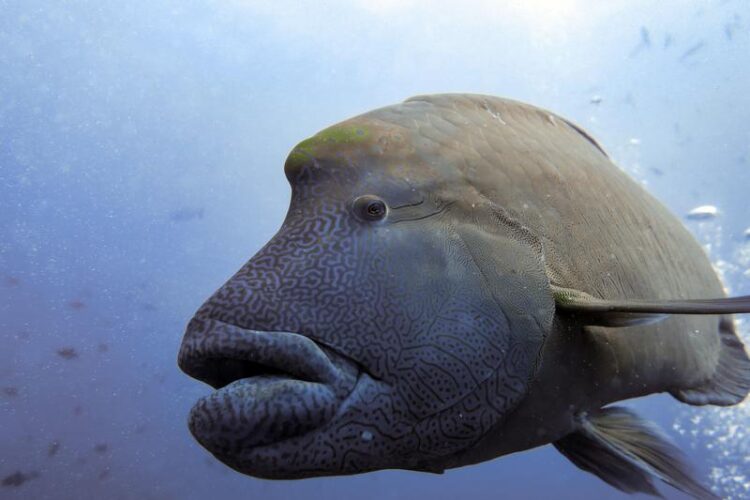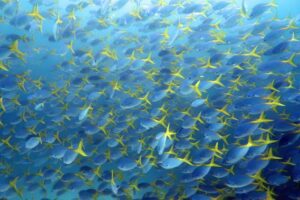Warming and overfishing

The Napoleon wrasse (Cheilinus undulatus), here off Palau, can grow up to two meters. It is considered an endangered species.
Credit: Mattia Ghilardi / Leibniz Centre for Tropical Marine Research
… could switch the role of fishes in the marine carbon cycle.
Fish make carbonates from marine salts within their guts and excrete them at high rates. These can sink and become part of sediments or dissolve and increase the water’s ability to neutralise acids. A new study in Nature Communications sheds light on the controls of carbonate excretion by fish.
Bony fish are more often recognised as food sources than as carbon regulators. They provide an array of services relevant to climate change mitigation. For instance, they store carbon within their bodies as they grow and export it to deep seas through their sinking faeces and carcasses. But they also make carbonates from marine salts within their guts and excrete them at high rates. This makes them especially important within the inorganic carbon cycle of the oceans.

Credit: Sonia Bejarano / Leibniz Centre for Tropical Marine Research
With plenty of fish in the sea, the importance of fish carbonates for the inorganic carbon cycle should not be underestimated. Fish carbonates can sink and become part of sediments or dissolve and increase the water’s ability to neutralise acids. They could therefore enhance the ocean’s capacity to buffer acidification. A new study in Nature Communications sheds light on the controls of carbonate excretion by fish. The findings advance our understanding of the biogeochemical and physical processes in the ocean in times of climate change.
Led by the Leibniz Centre for Tropical Marine Research (ZMT), a team of scientists studied a wide variety of fish species to determine how certain fish characteristics and environmental changes control the amount and composition of excreted carbonates. The team retrieved carbonates produced by fish from Palau, Australia and the Bahamas while keeping them within aquaria in conditions natural to their home reef. The researchers then compiled an extensive database of carbonate excretion rates from more than 380 coral reef fishes from 85 species, including damselfish, surgeonfish, parrotfish, wrasses, snappers and groupers.
Why do bony fish excrete carbonates?
Marine fish live in a salty environment that has a higher osmotic pressure than their blood. As a result, their bodies are deprived of water. “To hydrate, the fish drink seawater, but they have to get rid of the large amounts of calcium and magnesium contained in it”, explains Mattia Ghilardi, a marine biologist at the ZMT and lead author of the study. “These are precipitated in the gut in the form of carbonate crystals and released into the sea within the faeces.” Experts estimate that fish faeces account for 3-15% of global carbonate production in ocean surface waters.
Unlike corals and other carbonate producers, fishes create a wide spectrum of carbonate forms. Depending on their composition, these crystals can dissolve rapidly in the water column, or sink and remain buried within shallow coastal sands for a long time, thus contributing to the formation of muddy sediments. Global warming and overfishing can alter the amount of carbonates produced by fishes, and ultimately dictate which carbonate form is excreted the most. This can tweak completely the role fish play in the ocean’s inorganic carbon cycle.
It has long been assumed but not demonstrated that fish carbonate excretion is proportional to their metabolism. The scientists strongly confirmed this. High temperatures, for example, boost metabolism and carbonate excretion. Fish with forked or lance-shaped tails are more active and thus excrete more carbonates than fish with rounded tails. Interestingly, the length of the gut also plays a role: like temperature, it affects the amount and mineralogical composition of the excreted crystals.
Changes in marine chemistry possible
Global warming and the overfishing of certain fish species may significantly upset the contribution of fish carbonates to the marine inorganic carbon cycle. For example, fishing pressure on fish that are high up the food chain could lead to a sharp decline in carbonate excretion. Climate-driven changes in fish size may exacerbate this effect. Warmer temperatures favour the production of highly soluble fish carbonates that form less sediment. All of these factors influence marine chemistry and potentially the ocean’s capacity to buffer further atmospheric CO2.
The new findings will enable researchers to more reliably calculate the amount and composition of carbonates produced by fish communities in different marine regions and worldwide. “With our study, we pave the way for more accurate predictions about the role of fish in the marine carbon cycle under changing conditions such as climate warming and overfishing,” says co-author Sonia Bejarano, reef ecologist at the ZMT. “Such predictions are very important for management and decision-making processes aimed at maintaining ecosystem functions.”
Wissenschaftliche Ansprechpartner:
Dr. Sonia Bejarano
WG Reef Systems
Leibniz Centre for Tropical Marine Research (ZMT)
Phone: +49 (0)421 23800 – 51
Email: sonia.bejarano@leibniz-zmt.de
Originalpublikation:
Ghilardi M, Salter MA, Parravicini V, Ferse SCA, Rixen T, Wild C, Birkicht M, Perry CT, Berry A, Wilson RW, Mouillot D, Bejarano S (2023) Temperature, species identity and morphological traits predict carbonate excretion and mineralogy in tropical reef fishes. Nat Commun 14, 985 (2023). https://doi.org/10.1038/s41467-023-36617-7
Media Contact
All latest news from the category: Ecology, The Environment and Conservation
This complex theme deals primarily with interactions between organisms and the environmental factors that impact them, but to a greater extent between individual inanimate environmental factors.
innovations-report offers informative reports and articles on topics such as climate protection, landscape conservation, ecological systems, wildlife and nature parks and ecosystem efficiency and balance.
Newest articles

NASA: Mystery of life’s handedness deepens
The mystery of why life uses molecules with specific orientations has deepened with a NASA-funded discovery that RNA — a key molecule thought to have potentially held the instructions for…

What are the effects of historic lithium mining on water quality?
Study reveals low levels of common contaminants but high levels of other elements in waters associated with an abandoned lithium mine. Lithium ore and mining waste from a historic lithium…

Quantum-inspired design boosts efficiency of heat-to-electricity conversion
Rice engineers take unconventional route to improving thermophotovoltaic systems. Researchers at Rice University have found a new way to improve a key element of thermophotovoltaic (TPV) systems, which convert heat…



